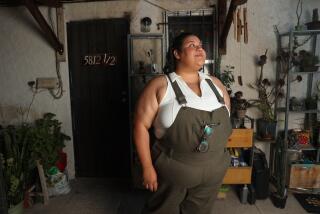Low-income projects come on line
- Share via
They will be the standout buildings on the block: snappy architecture, fresh paint, nice landscaping. The places where adults can get job training and kids, after-school care. The places that low-income working families can call home.
Thanks to Proposition 46, the $2.1-billion housing bond passed decisively by voters in November 2002, a slew of new rental projects for low-wage earners is underway statewide. The money, which is being raised and allocated in stages over five years, already has helped fund a mixed-use development for low-income families in Hollywood, apartments near downtown for working families, low-cost rentals in Hollywood for seniors at risk of homelessness, and housing for those with HIV.
Builders, legislators and low-income housing advocates laud the bond program but are worried about the potential loss of about $37 million to the general fund this year to help balance the budget, a move housing advocates say violates the intent and possibly the terms of Proposition 46.
An Assembly budget subcommittee recently rejected the proposal to shift the funds, but a final decision by the full Assembly and Senate has yet to be made.
Last year, about $40 million of Proposition 46 bond money was spent on previously approved housing projects that were supposed to be paid for out of the general fund.
That reallocation of bond money and the current threat to the fund has some officials concerned that the Legislature is setting a precedent that will encourage further raiding of the bond’s funds.
“That’s the risk to the housing bond,” said Assemblyman Alan Lowenthal (D-Long Beach). “The voters’ expectation was that money from Proposition 46 would go to new projects for affordable housing. To use that to pay old debt is a betrayal of the public trust.”
The main objection to using bond funds to pay for projects that were tapped for general-fund appropriation is that the desperately needed Proposition 46 housing dollars will dry up sooner than 2007, when they should be depleted. If the state still faces large budget deficits then, it’s unlikely that another housing bond issue will pass, experts say.
“We always want more, but Prop. 46 is a great start,” said Mercedes Marquez, head of the city’s Housing Department. “We hope the state will honor its commitment to make housing its top priority for this bond.”
It’s easy to understand why Los Angeles housing officials want to zealously guard Proposition 46’s coffers.
From the $68.5 million the city of Los Angeles has received so far, builders expect to produce 4,424 housing units and 215 shelter beds, according to the state’s Department of Housing and Community Development, which administers the program. Los Angeles County (including the city of Los Angeles) has been awarded $92.2 million, which will translate into nearly 7,200 housing units and 906 shelter spaces.
About $450 million has been allocated statewide so far, half for multifamily housing projects and the rest for 19 additional programs, including farmworker housing and homeless shelters. Builders are awarded bond dollars through a highly competitive process in which they are awarded “points” for their projects’ proximity to mass transit, on-site social programs and having additional funding already lined up.
Among the local projects that have won bond money so far is Hartford Avenue Apartments in the densely populated Westlake area of Los Angeles. The 54-unit multifamily housing development will provide apartments for working families that earn between 35% of Los Angeles’ area median income, or $23,800 annually for a family of four, and 60% of the area median, or $35,000 for a family of four.
The developers, a Community of Friends, entered into an agreement with the Los Angeles Unified School District to jointly create a master plan for Hartford Avenue, which calls for the street’s elementary school and new residential units to share open spaces and parking. An early-education center and boys’ and girls’ clubs will serve the neighborhood too. Construction of the units is scheduled to begin late this year.
“Proposition 46 and the Multifamily Housing Program have been a godsend,” said Dora Leong Gallo, chief executive of a Community of Friends. “It’s a savior to these programs in this economic climate. We couldn’t have done this project without those funds.”
Hollywood Community Housing Corp., a nonprofit development company, has begun construction of Views at 270, a 56-unit mixed-use project in Hollywood that will be anchored by a Walgreens drug store and be near bus and rail lines.
Encore Hall, a 103-unit Hollywood residential complex for low-income, disabled seniors at risk of homelessness, is a joint venture of McCormack Baron Salazar, a real estate development firm that specializes in redeveloping urban neighborhoods, and the Gay-Lesbian Elder Housing Corp. The project is scheduled to break ground at the end of the year.
The typical Proposition 46-funded project receives 33% of its capital from the state bond, which is a grant. The developers also rely on a package of city and county money and private funding to complete their building projects.
If all of the Proposition 46 money is allocated -- meaning the state doesn’t dip into that pot for budget-balancing purposes -- 130,000 units will be added to California’s housing stock, said Department of Housing and Community Development Director Matthew O. Franklin. An additional $150 million will be allocated by July.
For renters Mary and Rony Dominguez, who live in Hollywood Community Housing Corp.’s Innes Heights -- an Echo Park residential complex for low-income renters similar to the ones now being funded by Proposition 46 -- getting off the street into a safe, comfortable living space has turned their lives around.
Rony Dominguez, 23, an ex-drug addict and former gang member, works for an import company, and Mary, 20, receives job training and is taking parenting and stress-management classes at the complex when she’s not caring for their 9-month-old son, Bryan. The couple pays $307 a month for the two-bedroom unit.
“I’m so happy that I’m not cold and afraid at night anymore,” said Mary, who used to live under a freeway. “It’s my house. I have a bed to sleep in and the opportunity to do everything I couldn’t do before.”
More to Read
Get the L.A. Times Politics newsletter
Deeply reported insights into legislation, politics and policy from Sacramento, Washington and beyond. In your inbox twice per week.
You may occasionally receive promotional content from the Los Angeles Times.










